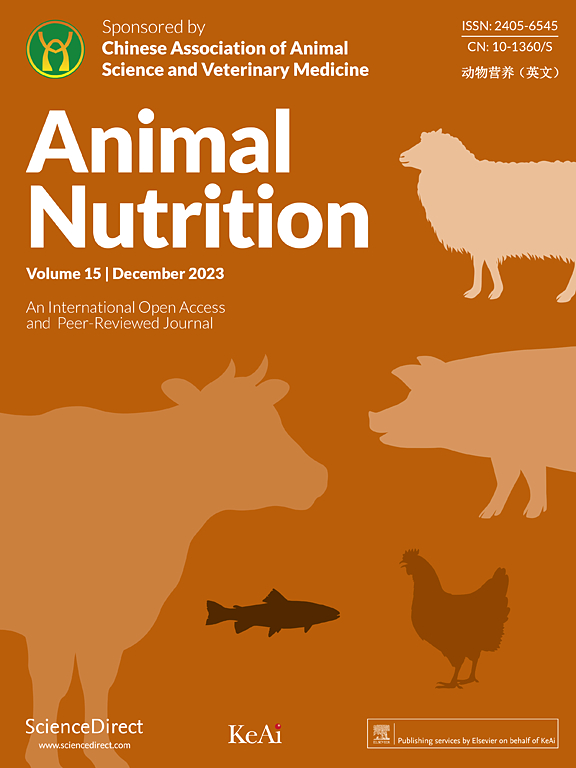辣椒素和辣椒素作为饲料添加剂在畜牧生产中的应用:当前和未来趋势
IF 6.1
1区 农林科学
Q1 AGRICULTURE, DAIRY & ANIMAL SCIENCE
引用次数: 0
摘要
人口增长和收入增加促进了对动物性食品的更大消费。为了提高家畜的产量,在生产动物的水和饲料中添加了亚治疗剂量的抗生素生长促进剂(AGPs)。不幸的是,抗生素的滥用与抗菌素耐药性(AMR)有关,导致它们在不同国家被禁止作为动物生长促进剂。近年来,植物化合物已成为对牲畜使用抗生素的替代品;在此背景下,从辣椒中提取的辣椒素和辣椒素已被体外和体内评价,显示出有趣的生物活性,如镇痛、抗菌、抗氧化、降血压、抗癌、降糖和减肥。辣椒中的辣椒素和辣椒素主要是作为治疗肥胖的替代品进行研究的;因此,关于这些植物化合物如何在动物营养中作为饲料添加剂使用时增加体重,存在一些空白,并且没有对在不同种类农场动物的饮食中使用辣椒提取物或粉末进行的大量研究进行总结,这些研究包括生物效应,建议剂量以及与其他植物化合物或药用植物的可能混合物。因此,本文综述了辣椒AGPs和辣椒素在改善动物健康、促进生长和生产力方面的作用机制的最新进展。总结了饲粮中添加辣椒对农场动物的生物学效应,以及促进鸡、猪和反刍动物生长的有效剂量。最后,强调了agp和辣椒化合物在家畜营养中的应用的未来趋势和挑战。本文章由计算机程序翻译,如有差异,请以英文原文为准。
Capsaicinoids and capsinoids of chilli pepper as feed additives in livestock production: Current and future trends
Population growth and income increase have promoted a greater consumption of animal-based food. To increase the yield of livestock animals, antibiotic growth promoters (AGPs) have been provided at sub-therapeutic doses in water and feed for production animals. Unfortunately, the misuse of antibiotics has been associated with antimicrobial resistance (AMR), resulting in their ban as animal growth promoters in different countries. In recent years, phytocompounds have emerged as an alternative to substitute the use of antibiotics on livestock; in this context, capsaicinoids and capsinoids from Capsicum chilli peppers have been evaluated in vitro and in vivo, exhibiting interesting biological activities, such as analgesic, antimicrobial, antioxidant, hypotensive, anticancer, antidiabetic and slimming. Capsinoids and capsaicinoids of chilli pepper have been mostly studied as alternatives to the treatment of obesity; thus, there are several gaps regarding how these phytocompounds enhance weight gain when used as feed additives in animal nutrition and there is no summary of the plethora of research that has been carried out using Capsicum, in extract or powder, in the diet of different species of farm animals that includes the biological effects, suggested doses and possible mixtures with other phytocompounds or medicinal plants. Therefore, this review addresses updates on the mechanisms of action of AGPs and capsaicinoids from chilli pepper to improve animal health and promote growth and productivity. Additionally, the biological effects on farm animals after the addition of Capsicum in the diet are summarized, as well as the effective doses to promote growth in chickens, pigs and ruminants. Finally, future trends and challenges about the use of AGPs and chilli pepper compounds in livestock nutrition are highlighted.
求助全文
通过发布文献求助,成功后即可免费获取论文全文。
去求助
来源期刊

Animal Nutrition
Agricultural and Biological Sciences-Animal Science and Zoology
CiteScore
7.40
自引率
3.20%
发文量
172
审稿时长
12 weeks
期刊介绍:
Animal Nutrition encompasses the full gamut of animal nutritional sciences and reviews including, but not limited to, fundamental aspects of animal nutrition such as nutritional requirements, metabolic studies, body composition, energetics, immunology, neuroscience, microbiology, genetics and molecular and cell biology related to nutrition, and more applied aspects of animal nutrition, such as raw material evaluation, feed additives, nutritive value of novel ingredients and feed safety.
 求助内容:
求助内容: 应助结果提醒方式:
应助结果提醒方式:


